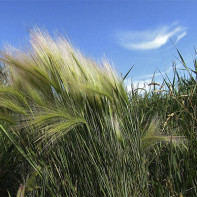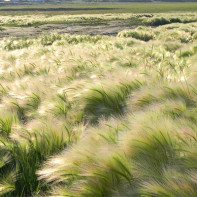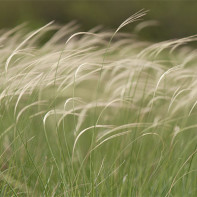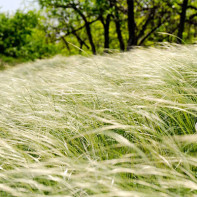Feather grass: medicinal properties and contraindications
Many people are well aware of the tall, shiny, attractive grass with beautiful hairy spikelets, waving in the wind like green waves - the feather grass. It belongs to the cereal family.
- Chemical composition
- How it looks and where it grows
- Views
- Collection and storage
- Healing properties of feather grass
- Feather grass in folk medicine
- For treating goiter
- For paralysis
- Milk decoction for paralysis
- From sciatica
- From joint pain
- From prostate adenoma
- For sleep disorders
- From stomatitis
- Types of healing compounds
- Infusion
- Tincture
- Decoction
- Contraindications
Chemical composition
Since official medicine does not use feather grass, scientists did not plunge into the depths of its chemical composition either. To date, it has only been established that in the midst of flowering, grass is more than 35% fiber. It also has protein protein, its proportion is about 10.8%, and a little fat - about 2.7%.
Botanists note the presence of cyanogens, such as trigloquinine, in the leaves. Cyanogenic compounds contain hydrocyanic acid, therefore, in sufficiently large doses they are toxic, in small quantities they can have a calming and analgesic effect on the body.
How it looks and where it grows
A feather grass is a perennial grass of a very characteristic appearance with narrow long leaves, flexible and at the same time rigid, similar to a wire, because quite often they are twisted by a tube.
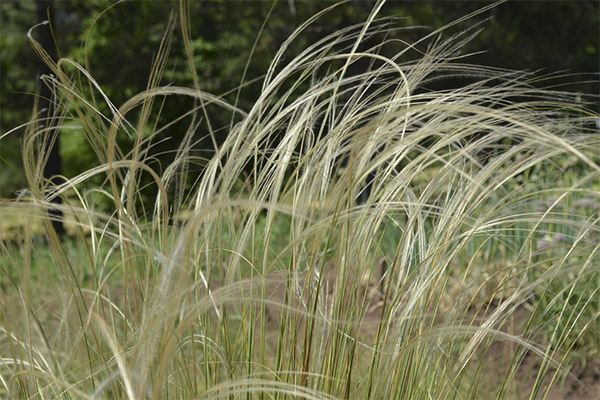
Above the leaves, inflorescences rise in the form of a magnificent panicle collected from several spikelets, rising a meter above the ground. The feather grass begins to bloom in late May - early June. Each ear in the inflorescence is one-flowered, with a pair of hiding scales. He holds a seed that rests quite firmly in his bed until ripe due to a long beautiful spine that looks like a feathery “hair”, and falls off after ripening.
Spikelets are so sharp that they cause serious wounds to the tongue of animals that decide to eat a feather grass. On the mucous membrane of the oral cavity of animals ulcers and nonhealing fistulas form, this condition is even called the feather-grass disease, which often leads to death. Hence the second name of the feather grass is sheep death. Therefore, despite the rather high nutritional value, it is not recommended to feed the animals with a feather grass, and if you still use it for food purposes, then only in May, before flowering begins.
The feather grass differs in the weak development of the root system. Its rhizome is short, unable to stay on dense and powerful sod meadow meadow. But for some reason the turf should weaken and lose its fertile properties, for example, due to the prolonged absence of rain, after burning last year’s dry grass in spring, the feather grass, like a real aggressor, very quickly occupies the territory. It grows in groups, bumps, whole turfs.
Feather grass is mainly a steppe plant that prefers poor soils; it is characterized by wind and drought tolerance. It can also settle on dry hills and rocks at the foot of the rocks. Its huge locations occupying the virgin lands of Kazakhstan are very beautiful. The expanses of Donetsk and Kherson regions of Ukraine are especially rich in feather grass. In Western European countries, grass occupies large dry areas in Spain and Hungary. In Russia, the main place of grass growth is the southern Siberian regions, the middle Urals and Transbaikalia, in Asia - semi-desert sections of the Gobi desert, Mongolia and China, as well as the territory of the Azov and Caspian seas. Some species are found in northern Africa - in a number of Moroccan and Algerian regions.
As soon as night falls on the steppe where the feather grass grows, the air becomes colder and the plants become covered with dew, the leaves twisted into a tube begin to straighten, cease to be rigid and elastic, and bend to the ground - so that the inflorescence-panicle lies on the ground.
With the first rays of the sun, the dew slowly dries up, the grass straightens.But the seeds remain seeds, which after rain give life to new plants.
Thanks to the spectacularity, beauty and undemanding to the soil, the feather-grass was fond of flower growers and “moved” to personal plots. Some of its varieties began to be actively used by landscape designers to decorate territories.
Views
A feather grass is a plant richly represented by all sorts of varieties. Biologists today have about 300 of its species, in Russia you can see 80 of them. Russian “inhabitants” are Zalessky's feather, feathery, hairy, finest, magnificent, beautiful.
The feather grass of Zalessky, except the southern Urals, Siberia, and the southern regions of the European part of Russia, is found on the steppe and rocky soils of Europe and China. It has smooth stems that do not grow above 70 cm, and the tube of leaves is wide and loose.
The feathery feather grass is characterized by a slight roughness of the leaves and a light fluff covering the stems of inflorescences having a brownish color. Its arrows, reminiscent of a bird's feather (from where the name of the species came from), can stretch in height from 30 cm to 1 m, while the inflorescences reach a length of 25 cm. Narrow leaves are folded into tight dense tubules. Such a feather grass is increasingly becoming a guest in personal plots; gardeners decorate flower gardens with it.
The leaves of the beautiful feather grass are distinguished by the presence of a large number of branches, at the base of which the fluff is clearly visible. No wonder this species of plant got its name! He is really very beautiful: his lower foliage is painted in a darker color than the upper, and panicles of inflorescences of a reddish hue, narrow, as if compressed, are covered with small hairs. This type of feather grass prefers to climb rocks and mountain plateaus, where it survives well in calcareous rocks. But found in recent years less and less.
The finest feather grass is characterized by harsh leaves and strong stems about 70 cm high. The lilac-violet panicles do not grow larger than 20 cm. Unlike relatives, it loves fertile chernozem soils. He comes from Mexico and is rarely found in nature, but is quite actively grown in flower gardens.
The feathery grass-leaved, or hairy, as his people called it, is a plant not very large, up to 60 cm, with leaves of green-gray-gray color. Hair covers both flowers and spines.
The magnificent feather grass reaches a height of 75 cm. The width of the leaves is about 7 mm. He flooded the rocky mountain slopes of the Ural Mountains and Altai with Samosiev.
A rare species is the feather grass. Its homeland is the mountainous terrain of Tibet, Afghanistan, the Pamirs and the Tien Shan. Not very tall, up to 40 cm, its leaves, forming a turf, stick out of it like bristles. But the panicle inflorescences surprise with beautiful long hairy outer hair. His closest relatives, very similar, also live in mountainous areas - the Caucasian feather grass and Lessing. The first took root in the foothills of the Caucasus, the second in the European subtropics.
There are species that grow in limited regions, and their name speaks for itself. So, there is Ukrainian feather grass, it is found in the steppes near the Black Sea, in the Krasnodar and Stavropol Territories. This is the shortest species, it does not happen above half a meter, its panicle is small and nondescript. A rather rare variety, protected by the laws of Russia and Ukraine.
The feather grass Far East grows in China, Japan and in the extreme eastern regions of Russia. This is a real giant! 180 cm tall specimens are not uncommon, with the panicles being long, and the remaining hairs of 50 cm each give it an incredibly chic look. To match the dimensions of the plant and leaves - they are wide in comparison with other varieties and are up to 3 cm wide.
With all the great species diversity of the feather grass, this aggressor is losing its position: its natural populations have been declining in recent years due to the development of fallow lands by agricultural producers. Therefore, many species of plants appear in the Red Book as endangered.
Collection and storage
Traditional medicine has learned to prepare healing potions from all parts of the plant - roots, leaves with stems, seeds and spines.
For medicinal purposes, the green part of the feather grass begins to be collected in the last week of May or early June, during flowering. Cut the plant as close to the surface of the earth as possible. They do this in dry weather, not necessarily sunny, the main thing is that the grass is not damp due to dew or rain. The collected raw materials are dried in a shaded place inaccessible to sunlight, with good ventilation. You can build a kind of hammock from a grid with medium-sized cells and spread the grass on this “bed” - so it will be aired from all sides.
The roots are dug in autumn, washed and, like grass, dried in a draft where there is no access to the sun.
Grind the raw materials at a convenient time. After drying, it is immediately grinded in a coffee grinder (but not into powder, but approximately to the size of tea) and packaged in paper bags or cotton bags. You can remove the whole raw material for storage, and crumble it immediately before brewing.
Store the dried feather grass in a dark, dry room or in a closet in a normal room. In such conditions, it will retain its healing properties for two years.
Healing properties of feather grass
Despite the fact that there are many types of feather grass, only one of them, cirrus, has drugs. Traditional healers have noticed that this plant gives a good result in the treatment of a number of ailments, in particular thyroid diseases, as well as multiple sclerosis and paralysis, especially one-sided post-stroke. The plant is effective for eliminating rheumatic and radiculitis pains, alleviating the condition with prostate adenoma due to the ability to improve blood flow and remove inflammation. The anti-inflammatory ability of the feather grass is also based on the appointment of doctors as a healer for the treatment of mucous membrane problems.
Cyanogens, which are part of the feather grass, endow it with calming and soothing effects, so they are recommended in cases where you need to relieve pain, tension or fatigue, calm the nerves and relieve stress.
Feather grass in folk medicine
In folk medicine, the entire plant has been used for centuries - both leaves and roots with seeds. Of these, tinctures, infusions and decoctions are made, which are then taken orally and used for poultices, compresses and lotions. But especially valuable are the compositions of the spine. Moreover, feather grass can be used both independently and as part of herbal mixtures.
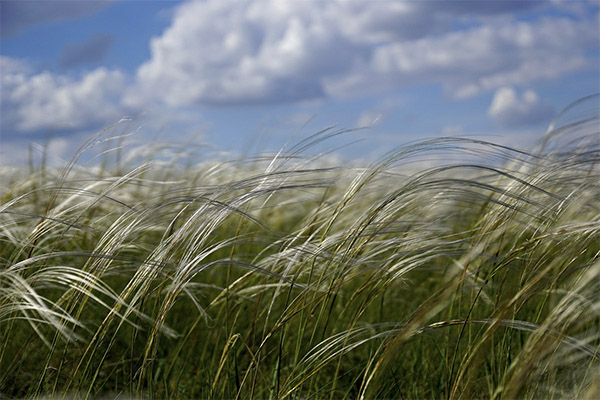
For treating goiter
Goiter appears as a result of an enlarged thyroid gland. To prepare a remedy for getting rid of this problem, you need to make a milk broth: boil 5 minutes in 250 ml of milk, 2 teaspoons of dried crumbled grass of feather grass, let the composition brew for 30 minutes. After filtering, drink the broth in small sips, stretching the resulting portion for the whole day. You can wet a gauze napkin in it, put it on the thyroid gland in the form of a lotion, cover it with plastic wrap and lie down for 30–40 minutes.
For paralysis
To reduce the manifestations of paralysis, you need to make an herbal collection in which to mix the seeds of the mordovian grass taken equally and the dry crushed grass of the feather grass. Pour 2 teaspoons of the mixture of medicinal plants into a thermos, add a glass of boiling water there and leave overnight. If there is no thermos, you can cover the container with the composition with a lid and wrap it with a woolen scarf. Also leave to insist all night. In the morning, filter the infusion, the resulting volume is the norm of the drug for the whole day. Drink in small sips. In this recipe, feather grass acts as an enhancer of the action of the mordovia - a recognized remedy that allows you to quickly recover from a stroke. You can buy a muzzle at a pharmacy.
Milk decoction for paralysis
Pour a tablespoon of dried feather grass into a glass of milk brought to a boil. Simmer for 15 minutes over low heat, then insist for another hour under a closed lid. Strain and drink a tablespoon before sitting at the table for breakfast, lunch or dinner. Alternate every other day this milk broth with a decoction prepared on water.
From sciatica
For the treatment of radiculitis, rheumatism, inflammatory processes in the joints, alcohol products are used. Pour a teaspoon of the drug collection made from dry feather grass raw material with mordovia seeds in equal proportions, pour 100 ml of alcohol and leave for 20–25 days at a temperature of 22–25 degrees in a dark place - for example, in a cupboard. To rub sick joints with this compound.
From joint pain
Boil 2-3 handfuls of chopped feather grass in 200 ml of water for 5-10 minutes and leave the medicinal raw materials to steam. When the composition becomes warm, strain the grass and apply it as an application to the affected joint. Cover with plastic wrap and tighten with a warm woolen scarf for half an hour.
From prostate adenoma
Mix in equal proportions grass feather grass and horsetail. Take 150 grams of the mixture (about 3 handfuls) and bring them to a boil in 3 liters of water. Then insist an hour. After straining, use the liquid to prepare the bath: pour into a basin, add 3-4 more liters of water and sit in it. The duration of the procedure is 30 minutes, it is better to carry out it at night, before going to bed, for 7-10 days. To make the treatment go faster, you can combine taking such a bath with an enema made of chamomile, which is done an hour and a half before the bath. After the procedure, do not walk around the house and do not cool the body, but rather take cover with a blanket for warmth.
For sleep disorders
If sleep is disturbed due to some stressful situations at work, worries and overexcitability of the nervous system, it is recommended to take an infusion of grass from a feather grass in a mixture with mint for the night. A teaspoon of mint and half a teaspoon of feather grass pour 300 ml of boiling water and leave for 15-20 minutes. When infused, drink with a spoonful of honey and go to bed. Before brewing, you can add half a ring of lemon or a drop of lemon peel to the container with herbs. Delight from amazing taste and smell, as well as a calm sleep are guaranteed!
From stomatitis
You can soothe pain in the mucous membranes and relieve redness and inflammation with the help of milk decoction of feather grass. Pour a teaspoon of dried medicinal raw material into half a glass of boiled milk and leave it to brew for about an hour and a half. With a cotton swab, carefully, trying not to injure, lubricate the places of redness and sores in the mouth until recovery.
Types of healing compounds
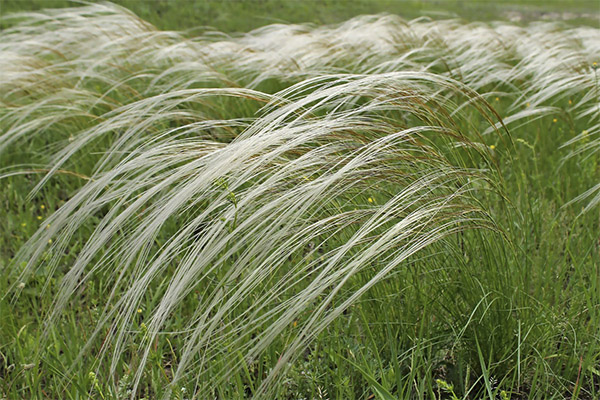
Infusion
Option on the water
To alleviate the symptoms of paralysis, you can prepare an aqueous infusion of feather grass and replace it with the usual tea party. It is necessary to brew it from the roots of a medicinal plant, any - both fresh and dried, are suitable. Take 4 tablespoons of medicinal raw materials per liter of boiling water. Fill the roots with liquid, cover and leave for about 2 hours. Before use, dilute the cooled composition with hot water.
You can eat with a decoction a spoonful of honey or jam, it is permissible to put sugar in a cup.
Option on milk
In the evening, steam in a thermos with hot milk 2 tablespoons of chopped dry feather grass leaves. Insist all night, in the morning a daily portion of the healing composition will be ready, with which you can treat the thyroid gland and goiter. Strain the product, drink the liquid in small sips. Steamed grass is perfect for lotions that are placed on the neck in the area of the thyroid gland.
Tincture
To treat sciatica and rheumatism, take half a teaspoon of dry feather grass and mordovia seeds, put in a glass dish of dark glass, pour 100 ml of alcohol there. 3 weeks to insist composition in a place inaccessible to the sun.At the end of this period, strain the tincture and rub it with aching joints, reduced by muscle spasm. Additionally, to more quickly alleviate suffering, you can drip 20 drops of tincture in a glass, dilute it with 50–70 ml of water and drink in the mornings and evenings after meals.
If the same amount of alcohol is taken not in half, but in a whole teaspoon of medicinal herbs, then the tincture will be more saturated. It can be rubbed not only with rheumatism, but also with multiple sclerosis. But to take inside the composition of this concentration should not be.
Decoction
In milk
To speed up recovery and reduce rehabilitation time after a stroke, traditional healers recommend a decoction in milk. The same tool will help in the treatment of paralysis.
Bring 2 cups of fresh milk to a boil and put 2 tablespoons of dried feather grass leaves in it. Boil the product on low heat for 15–20 minutes, then insist for another hour. Strain the composition, divide the liquid equally for 2 days and drink in small sips.
The remaining cake can be used for compresses and lotions.
On the water
Such a composition can also be used to alleviate the condition in paralysis or after a stroke. Take a glass of water, in which bring to a boil a large spoon with a slide of a medicinal plant. Boil for 15 minutes and insist an hour. After filtering, you can drink the resulting liquid. If you soften it, pour a little milk, as in regular tea, and the taste will be more pleasant, and the therapeutic effect is more noticeable. Take this broth twice a day - before breakfast and dinner.
Contraindications

People with allergies should be very careful with feather grass. Not only medicinal compounds based on this medicinal plant, but even a beautiful bouquet of panicle inflorescences used to decorate the interior can provoke an asthmatic attack. When using compresses, lotions and rubbing, allergies can be manifested by redness of the skin and a rash.
Pregnant women and mothers who are breast-feeding a baby are not recommended to use feather grass products, since it is not possible to predict what effect they will have on the baby.
Even if the patient is not among the allergy sufferers, when preparing and using the preparations made of feather grass inside, one must be on the alert, impeccably observe the recommended proportions and in no case exceed the concentration. Otherwise, poisoning is possible. Its symptoms: dizziness, nausea, cutting abdominal pain, severe weakness.
Before deciding on the start of treatment with feather grass-based formulations on your own, you need to talk with your doctor and listen to his recommendations in this regard.
«Important: all information on the site is provided exclusively in fact-finding purposes. Before applying any recommendations, consult with a profile specialist. Neither the editors nor the authors are liable for any possible harm caused materials. "

